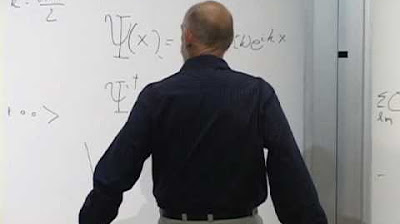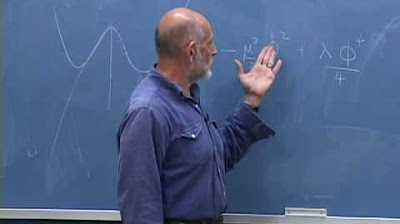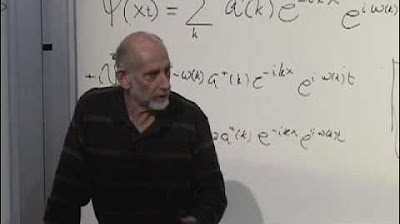Lecture 1 | New Revolutions in Particle Physics: Standard Model
TLDRThe transcript appears to be a lecture from Stanford University, delving into the intricate details of quantum mechanics and particle physics. It explores the concept of fields and their quanta, or particles, as discrete units of energy. The lecture touches on the fundamental properties of particles, such as energy, momentum, spin, and their classification as fermions or bosons. It also discusses the generation of field equations from Lagrangians and the representation of particle interactions through these equations. The lecturer further explains the relationship between fields, particles, and forces, illustrating how each field corresponds to a specific force and particle. The discussion encompasses a range of topics from electrodynamics to molecular forces, highlighting the exchange of particles as a basis for understanding forces. The lecture concludes with an overview of various elementary particles, their properties, and their role in the standard model of particle physics, emphasizing the complexity and unanswered questions within the field.
Takeaways
- 🚩 The relationship between fields and particles is central to quantum mechanics, with fields being seen as waves and particles as the quanta or discrete units of these waves.
- 🌀 Particles are categorized as either fermions, which do not like to share the same state, or bosons, which can congregate and occupy the same state.
- 📓 Field equations, derived from Lagrangians, are used to describe the interactions between particles, with terms in the Lagrangian representing processes where particles are emitted or absorbed.
- 🤔 The concept of elementary particles versus composite particles is a complex one, with the distinction often being 'slippery' and not absolute.
- ✨ Forces are associated with fields, and every field has a corresponding particle and force, such as the electric field and electric force, or the gravitational field and gravitational force.
- ⚖️ The electric field's energy, which is proportional to the square of the electric field, contributes to the mass of a particle, as per E=mc^2.
- 🧲 The force between two particles can be understood through the exchange of virtual particles, a concept key to quantum field theory.
- 💡 Quantum mechanical tunneling allows particles to move between different states, even when classically they appear to be trapped, which influences the energy and force between particles.
- 🔬 The standard model of particle physics, while complex and not fully understood, organizes particles based on their properties, such as fermions and bosons, electric charge, baryon number, and mass.
- ⚛️ Quarks are fundamental particles that combine to form protons and neutrons, and they are characterized by their baryon number, electric charge, and mass.
- 🧬 Mesons are composite particles made of a quark and an antiquark, and they have integer electric charges but zero baryon number.
Q & A
What is the relationship between fields and their quanta?
-The quanta are the discrete indivisible units of energy that quantum mechanics implies for waves. Waves, in turn, are fields, so fields and waves are more or less the same thing. The quanta are essentially the quantized form of these fields.
What are fermions and bosons?
-Fermions are particles that do not like to live together in the same state, following the Pauli Exclusion Principle. Bosons, on the other hand, are particles that can congregate and condense into the same state. Every particle in quantum mechanics is either a fermion or a boson.
How can field equations be generated from Lagrangians?
-Field equations can be generated from Lagrangians using the action principle, which is a variational principle that leads to the equations of motion for a dynamical system. The quantum mechanical version of the Lagrangian is a tool for codifying the interactions between particles.
What is the significance of the term 'vertices' in the context of the Lagrangian?
-In the context of the Lagrangian, 'vertices' refer to the points where particles come in and other particles go out, representing processes in particle interactions. Terms in the Lagrangian, such as products of fields, correspond to these vertices.
What is the concept of 'renormalization' in quantum mechanics?
-Renormalization is a procedure in quantum mechanics that deals with the infinities that arise in certain calculations. It involves redefining certain parameters of the theory to finite values, allowing for the calculation of physical quantities.
What is the difference between elementary particles and composite particles?
-Elementary particles are the fundamental particles that cannot be broken down into smaller particles. Composite particles, on the other hand, are made up of two or more elementary particles bound together by forces.
How does the concept of forces relate to fields in physics?
-In physics, for every field, there is a corresponding particle and a force. For example, the electric field gives rise to electric forces, and the gravitational field gives rise to gravitational forces. This relationship is part of the broader framework of field theory.
What is the significance of the electric field energy in the context of particle mass?
-The electric field energy, which is the energy stored in the space surrounding a charged particle, contributes to the total energy of the particle. According to the principle of mass-energy equivalence (E=mc^2), this field energy contributes to the mass of the particle.
What is the role of quantum mechanical tunneling in molecular forces?
-Quantum mechanical tunneling allows an electron to appear in the vicinity of more than one proton, even when classically it wouldn't have enough energy to do so. This process can lead to the formation of covalent bonds, where the electron shares a lower energy state between two protons, creating an attractive force.
How does the exchange of particles, such as photons, describe forces in quantum field theory?
-In quantum field theory, forces are often described by the exchange of particles. For example, the electromagnetic force between charged particles is mediated by the exchange of photons. This exchange is represented by Feynman diagrams, which illustrate the interactions between particles.
What is the role of the baryon number in particle physics?
-The baryon number is a quantum number that is conserved in strong and electromagnetic interactions. It effectively counts the number of baryons (such as protons and neutrons) minus the number of antibaryons. Each quark has a baryon number of 1/3, and each antiquark has a baryon number of -1/3.
Outlines
📚 Introduction to Quantum Mechanics and Particle Physics
The first paragraph introduces the fundamental concepts of quantum mechanics, including fields, quanta, and particles. It discusses the relationship between fields and particles, the discrete energy units of quanta, and the properties of particles such as energy, momentum, spin, and their classification as fermions or bosons. The paragraph also touches on the concept of field equations and Lagrangians, which are essential for understanding particle interactions.
🧲 Forces and Fields in Classical Electrodynamics
This paragraph delves into the concept of forces between particles from the perspective of classical electrodynamics. It explains how electric charges create electric fields that fill space and how these fields can be quantified by their energy density. The discussion also covers how the presence of multiple charges influences the total electric field and the potential energy associated with it, highlighting the connection between field energy, mass, and the concept of renormalization.
🤝 Particle Interactions and Molecular Forces
The third paragraph explores the idea of particle interactions and the origin of molecular forces. It uses the example of a pair of protons and a single electron to illustrate how particles can exist in states with the same energy and how quantum mechanical tunneling allows the electron to move between protons, creating an equilibrium state. This discussion leads to the concept of covalent bonds and the role of electron sharing in forming these bonds.
🔬 Quantum States and the Energy Landscape
The fourth paragraph continues the discussion on quantum states and energy as a function of distance between particles. It explains how the energy of a system changes as particles are brought closer together and how this can create an attractive force, such as a covalent bond. The paragraph also touches on the interplay between electrostatic forces and the forces resulting from electron sharing or tunneling.
🤔 The Nature of Quarks and Their Interactions
This paragraph examines the properties of quarks, which are fundamental particles that make up protons and neutrons. It discusses the concept of baryon number, a property that helps distinguish between different types of quarks. The discussion also considers the conservation of baryon number and the possibility of proton decay, a process that has not been observed but is theoretically predicted.
🌟 The Spectrum of Elementary Particles
The sixth paragraph provides an overview of the spectrum of elementary particles, emphasizing the complexity and variety within the standard model of particle physics. It discusses the properties of particles such as fermions and bosons, their electric charges, baryon numbers, and masses. The paragraph also highlights the lack of understanding regarding why certain particles exist and the challenges in organizing the vast array of particle data.
⚛️ Quark Composition of Protons and Neutrons
The seventh paragraph focuses on the composition of protons and neutrons in terms of quarks. It explains the charge and mass differences between up and down quarks and how these differences contribute to the overall mass of protons and neutrons. The discussion also touches on the concept of strange baryons, which are similar to protons and neutrons but contain strange quarks.
🤓 Mesons and Their Quark Composition
The eighth paragraph introduces mesons, which are composite particles made of a quark and an antiquark. It explains that mesons have integer electric charges and zero baryon number, distinguishing them from baryons. The discussion explores the different types of mesons that can be formed from up and down quarks, including pions and the eta meson, and touches on the concept of quantum superposition in the context of particle states.
🔬 Strange Mesons and the Quark-Antiquark Pairs
The final paragraph discusses strange mesons, which are mesons containing a strange or an anti-strange quark. It describes the different types of kaons, which are mesons that include strange quarks, and their electric charges. The paragraph also mentions that there are four types of kaons, consisting of charged and neutral varieties, and highlights that mesons can be involved in weak and electromagnetic interactions, leading to their decay.
Mindmap
Keywords
💡Quantum Mechanics
💡Fermion
💡Boson
💡Lagrangian
💡Field Quanta
💡Electrodynamics
💡Coulomb's Law
💡Quantum Tunneling
💡Baryon Number
💡Quarks
💡Meson
Highlights
Discussion on the relationship between fields and particles, emphasizing that quanta are discrete units of energy for waves, which are essentially fields.
Introduction to the concept that every particle is either a fermion or a boson, determining their behavior and how they can share space.
Explanation of how field equations can be generated from Lagrangians, which are fundamental in quantum mechanics.
Illustration of how the Lagrangian represents interactions between particles through terms that correspond to vertices in particle physics diagrams.
Introduction of the 'triangle of concepts' consisting of particles, fields, and forces, and their interconnectedness in modern physics.
Description of how forces are related to fields, with every field giving rise to a specific force, such as the electric field to electric forces.
Discussion on the concept of forces from a particle perspective, suggesting a correspondence between forces and particles.
Analysis of how the presence of two charges alters the energy between them and creates a force, as seen in classical electrodynamics.
Explanation of molecular forces, specifically how the sharing of an electron between two protons leads to an attractive force and the formation of covalent bonds.
Discussion on the role of quantum mechanical tunneling in allowing an electron to occupy states between two protons, influencing the system's energy and force.
Introduction to the concept of particle exchange as a mechanism for forces in quantum mechanics, paralleling the classical field theory perspective.
Description of the quantum mechanical equilibrium distribution of photons surrounding an electron and how it relates to the electromagnetic force.
Explanation of the conservation of baryon number and its significance in particle physics, including the possibility of baryon-violating processes.
Introduction and properties of quarks, including up, down, strange, charm, bottom, and top quarks, their charges, baryon numbers, and masses.
Discussion on the composition of protons and neutrons in terms of up and down quarks, and the slight mass difference between them.
Introduction to mesons as composite particles made of quark-antiquark pairs, having integer charges and zero baryon number.
Description of the pion multiplet and the eta meson, including their masses and the fact that they are longer-lived due to weak decay processes.
Mention of strange mesons, or kaons, which contain a strange or an anti-strange quark and come in charged and neutral varieties.
Transcripts
Browse More Related Video

Lecture 3 | New Revolutions in Particle Physics: Basic Concepts

Lecture 2 | New Revolutions in Particle Physics: Basic Concepts

Advanced Quantum Mechanics Lecture 7

Lecture 10 | New Revolutions in Particle Physics: Standard Model

Advanced Quantum Mechanics Lecture 8

Lecture 4 | New Revolutions in Particle Physics: Basic Concepts
5.0 / 5 (0 votes)
Thanks for rating: